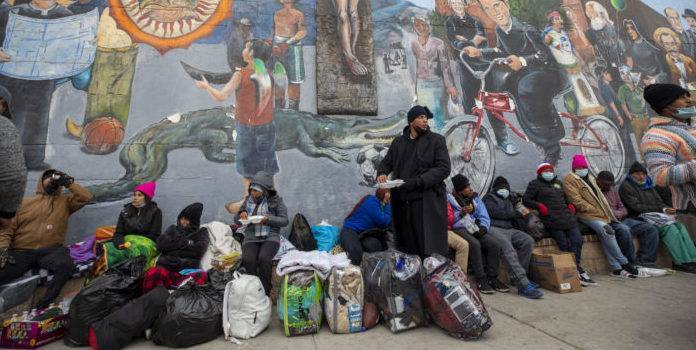(Headline USA) Suspense mounted at the U.S. border with Mexico on Tuesday about the future of a Trump-era safeguard holding back a flood of so-called asylum-seekers as the Supreme Court issued a temporary order to keep pandemic-rooted limits on migrants in place.
Conservative-leaning states won a reprieve—though it could be brief—as they push to maintain a measure that allows officials to expel many but not all asylum-seekers in the name of public health.
In a last-ditch appeal to the Supreme Court, they argued that an increased numbers of migrants would take a toll on public services such as law enforcement and health care and warned of an “unprecedented calamity” at the southern border.
Chief Justice John Roberts granted a stay pending further order, asking the administration of President Joe Biden to respond by 5 p.m. Tuesday, just hours before restrictions are slated to expire Wednesday.
The Department of Homeland Security, which is responsible for enforcing border security, acknowledged Roberts’s order—and said the agency would continue “preparations to manage the border in a safe, orderly, and humane way when the Title 42 public health order lifts.”
With the decision on what comes next going down to the wire, pressure is building in communities along both sides of the U.S–Mexico border.
In El Paso, Democratic Mayor Oscar Leeser warned that shelters across the border in Ciudad Juárez are packed to capacity with an estimated 20,000 migrants who are prepared to cross into the U.S.
Despite the court’s stay, the city of El Paso rushed to expand its ability to accommodate more migrants by converting large buildings into shelters, as the Red Cross brings in 10,000 cots.
Local officials also hope to relieve pressure on local shelters by chartering buses to other large cities in Texas or nearby states, bringing migrants a step closer to relatives and sponsors in coordination with nonprofit groups. A similar measure widely derided and condemned by the Left when Florida Gov. Ron DeSantis sent illegal immigrants to the blue enclave of Martha’s Vineyard earlier this year.
“We will continue to be prepared for whatever is coming through,” Leeser said.
Troops in tactical gear under Texas state command on Tuesday used razor wire to cordon off a gap in the border fence along a bank of the Rio Grande that became a popular crossing point in recent days for migrants who waded through shallow waters to approach immigration officials. They announced through a loudspeaker in Spanish that it’s illegal to cross there.
Texas said Monday that it was sending 400 National Guard personnel to El Paso, after city officials declared a state of emergency.
Leeser said the declaration was aimed largely at protecting vulnerable migrants, while the deployment included forces used to “repel and turn-back illegal immigrants,” according to a Texas National Guard statement.
A flashing signed warned motorists to “watch for unexpected pedestrians” on a highway that extends along the fenced-off border, near three bridges that connect El Paso with Mexico.
At a church-affiliated shelter a few blocks from the border, migrants including children lined up early afternoon Monday in hopes of securing a bed for the night, accepting donations of food from a succession of cars bearing gifts. Police and municipal garbage workers arrived to remove abandoned blankets and discarded possessions.
The Rev. Michael Gallagher, a priest at Sacred Heart Church in downtown El Paso, said local faith leaders have been trying to pool resources and open up empty space.
On Tuesday, a gym at the church gave shelter to 200 migrants—mostly women and children.
Outside the church Monday, Jose Natera, a 48-year-old handyman from the Venezuelan town of Guaicaipuro, said he traveled for three months to reach El Paso, sometimes on foot, with no money or sponsors to take him further.
“I have to stop here until I can get a ticket” out, he said.
El Paso residents Roberto Lujan and Daniela Centeno handed out fruit, Hostess cakes, soda and chips at a street corner.
“I have to do it,” said Lujan, a 39-year-old construction worker. “I have kids and I know the struggle.”
Conservative-leaning states have argued that the federal government has no plan to deal with an increase in migrants—while in Washington, Republicans are set to take control of the House and make immigration a key issue.
Biden administration officials claimed they have marshaled more resources to the border in preparation for the end of Title 42, even though all signals pointed to the administration having intentionally let the rule lapse.
The extra resources included more Border Patrol processing coordinators, more surveillance and increased security at ports of entry, it claimed, but not extra enforcement officers.
About 23,000 agents are currently deployed to the southern border, according to the White House, although they are mainly there to provide extra support including maid service and luxury accommodations for illegals rather than to deport them.
Adapted from reporting by the Associated Press

